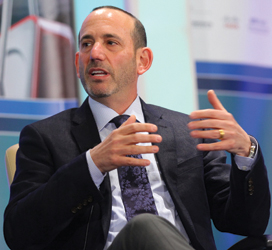One point of consensus that came out of the recent World Congress of Sports is that TV channels continue to value live sports over every other kind of programming. The leagues have taken notice, which means they expect big paydays when their current deals end.
Here are three quotes from the World Congress that struck me, because they demonstrate the power of live sports:
• “You can look at the NFL and bet the house they’re going to double their rights fees in the next negotiation.” — Tim Leiweke, president and chief executive officer of AEG
At a World Congress in 2003, CBS President and CEO Les Moonves delivered a keynote address in which he said, “The days of networks paying ever-escalating rights fees may be over.”
When Moonves’ quote was read to Leiweke in 2011, the AEG chief executive laughed. “Who said that? Les Moonves?” Leiweke asked. “That’s because he’s the guy paying.”
Live sports has never been more important for TV channels, which means rights fees should continue to soar, Leiweke said. He pointed to the fact that NFL games made up 18 of the top 20 TV shows last year as evidence that networks need to keep live sports on their schedules. “You’re going to see a doubling and tripling of rights fees going forward because they need that live content,” he said. “We live in a world that has attention deficit syndrome, and they have to find something that’s relevant.”
While live sports undoubtedly is important, IMG’s George Pyne said leagues also will begin to reap more money from highlight rights. “Think about ESPN without highlight rights,” he said. “If you couldn’t watch highlights on ESPN, would you watch?”
 |
GORT PRODUCTIONS
Garber sees a “massive positive mess” on the media landscape that can benefit sports. |
•
“Is Netflix a potential TV partner for somebody? Does YouTube get more engaged and start paying more money? There’s a massive opportunity with all this fractionalization getting our content directly into the hands of the consumer that’s going to provide us with value.” — Don Garber, commissioner of Major League SoccerGarber confidently predicted that MLS will see “multiple increases” when its media deals with ESPN and Univision expire in 2014. One main reason Garber believes rights will increase is that new bidders will emerge. He referenced YouTube’s deal with the Indian Premier League, which saw up to 50 million people stream cricket matches through the site.
“Ten years ago, we weren’t thinking about YouTube as a customer,” Garber said. “Maybe what ESPN has done to show you what that value could be through a cable sports channel, sometime in the near future could be a value for us through Netflix. We don’t know what that is today. But we think it’s going to be there somehow.”
Garber pointed to changes in the media landscape — from Time Warner Cable’s service streaming channels to iPads to telecom companies continuing to move into the cable business, as potential opportunities for sports leagues like his.
“It’s just this massive positive mess for all of us in the business,” he said, “and I think we’ll be the beneficiaries of it all.”
• “If it takes past May or June [for the NFL and NFLPA] to make a decision, I don’t know if these advertisers can wait it out and buy football hoping that it does turn around.” — David Levy, president of sales, distribution and sports for Turner
The TV advertising market for live sports — particularly the NFL — is as strong as it has ever been. But networks will start to feel the effects of the NFL lockout if there’s no resolution by next month.
That’s because advertisers typically commit to an NFL schedule during the upfront selling season, which wraps up by the end of May. Networks are concerned that advertisers will be reluctant to commit to such a schedule if there’s a possibility that games will be canceled. “If advertisers have to lay down their money in the fourth quarter, and there is no football and there is no NBA, that’s going to cause short supply, high demand and high pricing,” Levy said.
Some of that money can move to other sports, like college football and postseason baseball. “But there’s only so many slots,” Levy said. “There’s a huge amount of money put down on NFL football and NBA basketball that has to be absorbed in other places.”





